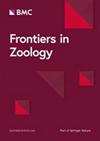Dispersion and new shelters offered by ants: myrmecophoresy of tardigrades
IF 2.6
2区 生物学
Q1 ZOOLOGY
引用次数: 0
Abstract
The present study investigates the potential role of ants as dispersal hosts for tardigrades and for the first time provides evidence of ant-mediated tardigrade phoresy. Tardigrades are microscopic cosmopolitan animals which have limited autonomous dispersal abilities but can withstand extreme conditions in a desiccated state. Being dominant terrestrial organisms, ants interact with many components of ecosystems, yet their role in dispersing meiofaunal organisms is unknown. In a field survey, four arboreal ant species were first analyzed to test the presence of tardigrades in their nests (i.e. tree galls), and on their bodies. In another experiment, galls were maintained isolated, then exposed to ant colonization to evaluate any transport of tardigrades by ants. Finally, the behavior of the ant Colobopsis truncata was tested by crafting an experimental apparatus to verify the actual phoresy of tardigrades. The field survey and gall colonization experiments show an association of tardigrades, especially with C. truncata. Gall colonization and laboratory experiments reveal that the ants transport tardigrades and other meiofaunal organisms, such as nematodes and rotifers. This phoresy can be direct (transporting animals) or indirect (transporting substrates with animals), over significant distances, thereby suggesting an unknown ecological interaction. Thanks to the widespread presence and abundance of ant species, this myrmecophoretic dispersion could play a crucial role in the spreading of meiofaunal organisms in terrestrial environments. These findings may represent just the ‘tip of the iceberg’ of an unexplored passive dispersal modality for terrestrial meiofauna micrometazoans, expanding our knowledge of phoretic relationships.蚂蚁的分散和新庇护所:缓步动物的蚁群
本研究探讨了蚂蚁作为缓步动物传播宿主的潜在作用,并首次提供了蚂蚁介导缓步动物传播的证据。缓步动物是一种微小的世界性动物,它们的自主扩散能力有限,但可以承受干燥状态下的极端条件。作为优势陆生生物,蚂蚁与生态系统的许多组成部分相互作用,但它们在分散小动物生物中的作用尚不清楚。在实地调查中,首先分析了四种树栖蚂蚁,以测试它们的巢穴(即树瘿)和身体上是否存在缓步动物。在另一项实验中,胆囊被隔离,然后暴露于蚂蚁殖民化中,以评估蚂蚁对缓步动物的运输。最后,通过制作实验装置来验证缓步动物的实际行为,对蚁群的行为进行了测试。野外调查和虫瘿定殖实验表明,缓步动物与此有一定的联系,尤其是与水熊虫。胆汁定殖和实验室实验表明,蚂蚁运输缓步动物和其他小动物生物,如线虫和轮虫。这种相互作用可以是直接的(运输动物)或间接的(与动物一起运输底物),距离相当远,因此表明存在未知的生态相互作用。由于蚂蚁种类的广泛存在和丰富,这种蚁群扩散可能在陆地环境中小动物生物的传播中起着至关重要的作用。这些发现可能只是陆地微后生动物尚未探索的被动扩散模式的“冰山一角”,扩大了我们对遗传关系的认识。
本文章由计算机程序翻译,如有差异,请以英文原文为准。
求助全文
约1分钟内获得全文
求助全文
来源期刊

Frontiers in Zoology
ZOOLOGY-
CiteScore
4.90
自引率
0.00%
发文量
29
审稿时长
>12 weeks
期刊介绍:
Frontiers in Zoology is an open access, peer-reviewed online journal publishing high quality research articles and reviews on all aspects of animal life.
As a biological discipline, zoology has one of the longest histories. Today it occasionally appears as though, due to the rapid expansion of life sciences, zoology has been replaced by more or less independent sub-disciplines amongst which exchange is often sparse. However, the recent advance of molecular methodology into "classical" fields of biology, and the development of theories that can explain phenomena on different levels of organisation, has led to a re-integration of zoological disciplines promoting a broader than usual approach to zoological questions. Zoology has re-emerged as an integrative discipline encompassing the most diverse aspects of animal life, from the level of the gene to the level of the ecosystem.
Frontiers in Zoology is the first open access journal focusing on zoology as a whole. It aims to represent and re-unite the various disciplines that look at animal life from different perspectives and at providing the basis for a comprehensive understanding of zoological phenomena on all levels of analysis. Frontiers in Zoology provides a unique opportunity to publish high quality research and reviews on zoological issues that will be internationally accessible to any reader at no cost.
The journal was initiated and is supported by the Deutsche Zoologische Gesellschaft, one of the largest national zoological societies with more than a century-long tradition in promoting high-level zoological research.
 求助内容:
求助内容: 应助结果提醒方式:
应助结果提醒方式:


